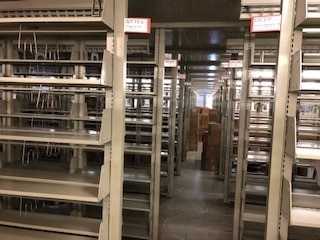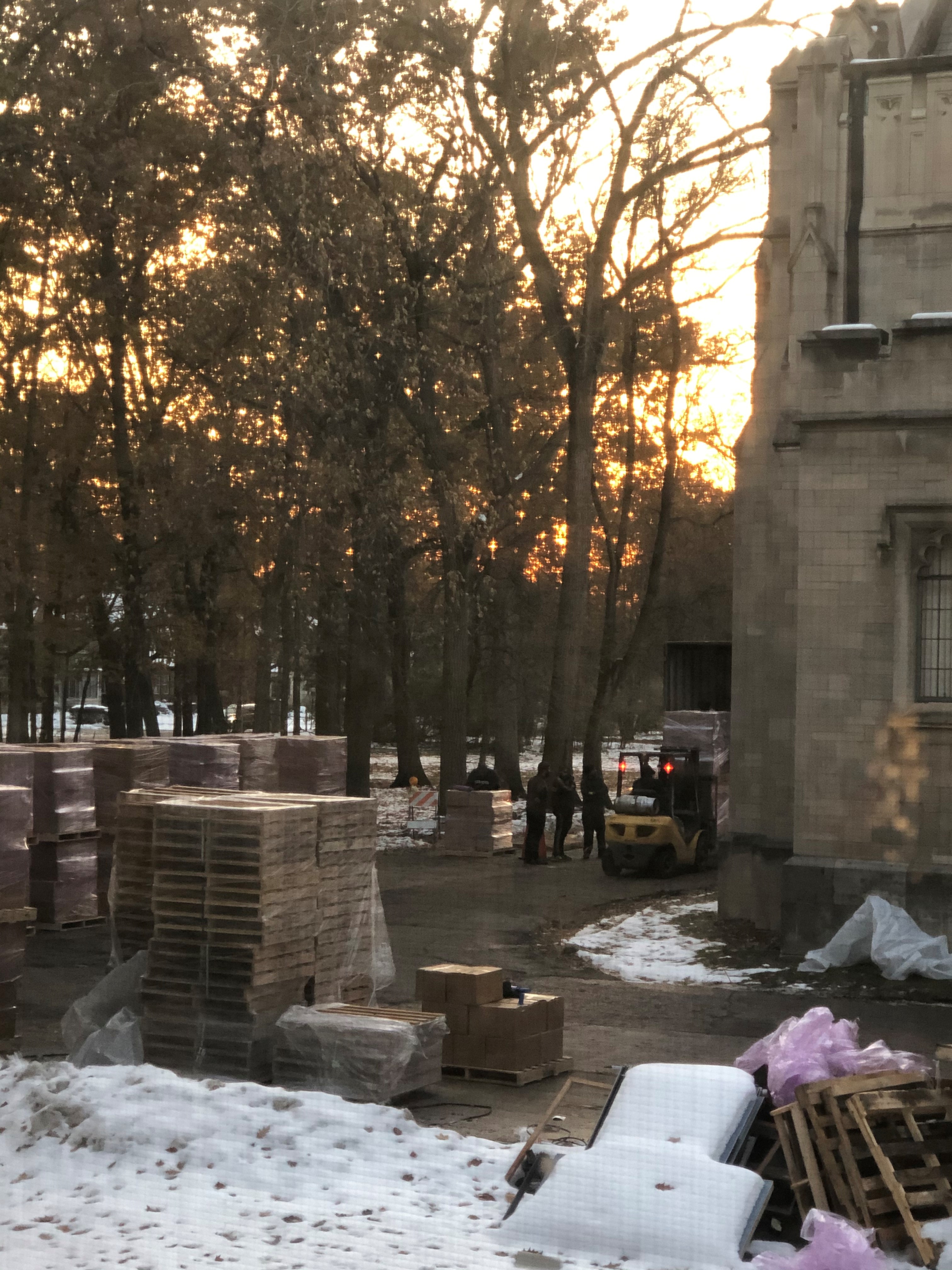You have /5 articles left.
Sign up for a free account or log in.

Marygrove College donated materials from its library to the Internet Archive.
Courtesy of Elizabeth Burns
When Marygrove College in Detroit made the decision to close at the end of its fall semester last year, the small Roman Catholic institution’s leaders needed to figure out what to do with its library collection.
Allowing book buyers to cherry-pick through the collection wasn’t a preferred option, according to Elizabeth Burns, Marygrove’s president. Neither was trashing a large number of items, which would go against the values of the college’s founding order, the Congregation of the Sisters, Servants of the Immaculate Heart of Mary.
Financial and legal details complicated matters. The college itself was closing amid enrollment and financial challenges, but its board was pursuing plans to transition its campus into a cradle-to-career destination that includes a high school and involves various public and private partners. That constrained how much money could be spent.
“We could not donate anything unless we could demonstrate to our board that it would cost more to dispose of it than to donate it,” Burns said.
Selling parts of the collection wouldn’t net very much money -- $3,000 for 3,500 books was Marygrove’s most likely offer, although it had a small chance of selling 32,000 books for $32,000. Buyers weren’t interested in many other media items like DVDs and microfilm, nor were they interested in journal volumes.
Even if Marygrove was able to sell 32,000 of its books, librarians estimated it would need to recycle tens of thousands of remaining books and journal volumes, paying as much as $595,000. And that was before it paid to have remaining items that couldn’t be recycled packed and sent to a landfill.
Officials at Marygrove talked with librarians at another Detroit institution, Wayne State University, who had interest in some collections, particularly those related to Detroit and Michigan. But they ultimately went a different, more novel route.
They donated the bulk of Marygrove’s collection to the Internet Archive, the nonprofit organization best known for its Wayback Machine, which preserves snapshots of websites over time. The Internet Archive took more than 70,000 of Marygrove’s books and journals to the San Francisco Bay Area, where it is preserving them and digitizing them.
 “I’ve got pictures of the packers and the books out on the driveway,” Burns said. “They shipped it out to be digitized, and they’ve started so that some of the collection is online now.”
“I’ve got pictures of the packers and the books out on the driveway,” Burns said. “They shipped it out to be digitized, and they’ve started so that some of the collection is online now.”
The Internet Archive uses controlled digital lending to loan print books digitally in a manner sometimes called lend like print. Under controlled digital lending, libraries own physical materials but make them available as digital copies. They only make available as many digital copies of a book or journal as they own physical copies.
But the type of lending that the Internet Archive uses is controversial. The organization is embroiled in a lawsuit with major publishers over whether it is legal or not.
In the meantime, the Internet Archive is progressing with the collection from Marygrove. Tuesday, it announced that items from the college’s library are now available online.
Other librarians may find the story of Marygrove’s library useful at this moment in time, when the COVID-19 pandemic is placing immense pressure on college and university finances and physical spaces like libraries. Speculation runs high that a wave of college closures may be on its way.
Even if that wave does not arrive, it’s possible libraries will be seeking responsible ways to downsize their collections, open up building space or lend materials digitally that haven’t been digitized by publishers themselves.
It’s not easy to navigate the logistics or the ethics of such changes.
Value in a Collection
The Marygrove collection was valuable in part because it provides a unique African American perspective, according to the Internet Archive’s leaders and those who worked for Marygrove. It’s a reflection of the local community in Detroit.
“The library offered just unbelievable access to all kinds of social justice information,” said Brenda Bryant, former dean and director of Marygrove’s social justice program, during a webcast Tuesday. “The collection was important, because in Detroit, reading is an act of resistance.”
The Marygrove materials would have helped fill a gap in similar collections at Wayne State, Mike Hawthorne, librarian at Wayne State, said during the same webcast. Some of the materials at the two libraries were repeats of each other, but the duplication wasn’t extensive.
Wayne State would have created a subcollection for the Marygrove materials, Hawthorne said. But talks didn’t work out as the end of the year approached.
“As we started talking about logistics and moving into the holiday, we just came to the conclusion at Wayne that it just, it wasn’t really a value-add to the community for us to take this collection,” Hawthorne said.
Worries about accessibility rose at Marygrove, according to Mary Kickham-Samy, who was director of Marygrove’s Geschke Library. She also spoke on the Tuesday webcast.
“It would not be more accessible at Wayne than it would be at Marygrove,” Kickham-Samy said. “We are academic libraries, not public libraries. There was a barrier to community access. That’s why it was a great solution to have the whole collection just digitized and put online.”
For leaders at the Internet Archive, value exists in having whole collections. Library collections aren’t just individual books thrown together. They’re curated, and they collectively reflect a place, an institution or a set of ideas.
“It’s not just a collection of books,” said Brewster Kahle, the Internet Archive’s founder and digital librarian. “A college library is the heart and soul of a community. Let’s have that live on in a new and different way. Having a complete library -- we’re thrilled.”
Legal and Ethical Issues
The Internet Archive is touting the digitization of materials from the Marygrove library at a time when it has been battling four major publishers in court over whether controlled digital lending is a legitimate concept.
At the beginning of June, Hachette Book Group, HarperCollins Publishers, John Wiley & Sons and Penguin Random House filed a lawsuit against the Internet Archive in U.S. District Court for the Southern District of New York, demanding a jury trial. They asked the court to declare the Internet Archive’s scanning and digital lending practices willful copyright infringement, and for the court to prevent the Internet Archive from reproducing copyrighted works that the publishers control. They also sought damages, attorney’s fees and other costs.
The lawsuit calls controlled digital lending an invented theory with rules that have grown worse. It pointed to a decision by the Internet Archive to suspend its one-to-one physical-to-digital lending ratio amid the pandemic.
“At first, under this theory, IA claimed to limit the number of scanned copies of a title available for free download at any one time to the number of print books of that title in its collection -- though no provision under copyright law offers a colorable defense to the systematic copying and distribution of digital book files simply because the actor collects corresponding physical copies,” the publisher’s lawsuit said. “Then, in the face of the COVID-19 pandemic, IA opportunistically seized upon the global health crisis to further enlarge its cause, announcing with great fanfare that it would remove these already deficient limitations that were purportedly in place. Today, IA offers an enormous universe of scanned books to an unlimited number of individuals simultaneously in its ‘National Emergency Library.’”
The Internet Archive has since gone back to the one-to-one lending rules. The National Emergency Library closed after 84 days, according to Chris Freeland, director of open libraries at the Internet Archive. It was always intended to be temporary, according to Freeland, and it closed two weeks earlier than its originally planned closure date of June 30.
But the publishers’ lawsuit still seeks to push back on the idea that print books can be digitized and lent out online merely because physical copies can be lent out by libraries. In some cases, libraries lend out titles as ebooks that are being digitized and lent out by the Internet Archive, creating direct competition, the lawsuit said. The publishers also argued that digital books are inherently different from physical books because they can be easily distributed around the world, because they do not degenerate over time and because they must be read on devices.
“IA does not seek to ‘free knowledge’; it seeks to destroy the carefully calibrated ecosystem that makes books possible in the first place -- and to undermine the copyright law that stands in its way,” the publishers’ lawsuit said.
Not at issue in the legal action are the Internet Archive’s Wayback Machine or digitization of public domain materials, the lawsuit said. At issue is the scanning of books in copyright and their distribution via the Internet Archive website.
“IA is a leader and organizer of a larger proselytizing movement of academics and activists seeking to find a way to justify a ‘scan first, figure out the details later’ approach to the mass digitization of copyrighted books,” the lawsuit said.
The Internet Archive responded with a filing at the end of July, saying that it is allowing those who do not live in world capitals to access the same cultural resources and information as those who do.
“The Internet Archive does what libraries have always done: Buy, collect, preserve, and share our common culture,” it wrote in its answer to the lawsuit.
Controlled digital lending allows the Internet Archive and other libraries to lend digital scans of physical books in their collections, replicating long-standing practices of brick-and-mortar libraries so that only one person can borrow a book at a time, the filing said.
“The Internet Archive’s CDL program is sheltered by the fair use doctrine, buttressed by traditional library protections,” the organization’s filing said. “Specifically, the project serves the public interest in preservation, access and research -- all fair use purposes.”
The filing said that the suspension of the one-to-one owned-to-loaned ratio came when the COVID-19 crisis prompted “urgent pleas from teachers and librarians” whose students and patrons were ordered to stay at home.
“Twelve weeks later, other options had emerged to fill the gap, and the Internet Archive was able to return to the traditional CDL approach,” it said.
The Internet Archive asked the court to dismiss the publishers’ suit and to enter judgement in its favor. It also requested attorneys’ fees and other costs stemming from the lawsuit.
Legal debates over controlled digital lending are important considerations for librarians seeking a new home for materials at this moment in time, said Roger Schonfeld, director for libraries, scholarly communication and museums at the consulting firm Ithaka S+R. So too are ethical questions about digitizing materials that weren’t previously available for widespread distribution, such as high school student newspapers that no one ever expected to be searchable decades later.
“If it’s published materials, it’s these copyright and access questions,” said Schonfeld, who was speaking about general issues and not the Marygrove case specifically. “If it’s archival materials, somebody’s papers, there are some really tricky ethical questions about what should be digitized and what should be made available how and when. Those are of course especially important for minority communities and certain kinds of endangered communities where knowledge and making it openly available may actually put people at risk.”
Other questions lurk about digitized materials taking the place of copies that used to be within walking distance of a community. Are copies accessible for low-income residents or those without access to the internet if they’re only available digitally? Does the experience of reading on a screen replicate the experience of seeing or touching an original document? Are some drawbacks acceptable if the alternative is for materials to be shipped to the dump or a campus miles away? Have donors restricted the ways any collections can be used or housed?
Road Map for the Future?
At Marygrove, the process of closing the library was not easy.
Classes were still going on as leaders prepared to close, so librarians had to be careful about which materials they could mothball and which had to remain available up until the last day of class. Marygrove was renovating the library building for a secondary school, meaning construction was taking place.
Leaders had little in the way of a road map. They drew heavily on an article from 1984, finding that much remained unchanged.
“I hope other librarians never have to experience closing their library,” said Kickham-Samy, Marygrove’s librarian. “There isn’t a lot out there on how to manage closing a library.”
Looking forward, using the Internet Archive to build a library of libraries is an interesting idea for Kahle, the organization’s founder.
“We are very interested in working with colleges and universities that are in transition -- or not,” he said. “Certainly, there is a tragedy of schools closing. But we’re seeing this transition happen in all colleges and universities. Let’s deliver the best libraries we can to anybody curious enough to want access.”
For college leaders, the case is a reminder that closing a college requires planning, difficult decisions and sometimes unexpected options.
“It’s sad, but you know, closing a college responsibly is as important as anything else,” said Burns, Marygrove’s president. “Once you make the decision, you can’t just hand over the keys to somebody and say, ‘See you.’ You really have to take care of your students, take care of your staff, and there’s a lot of cleanup that has to be done.”




